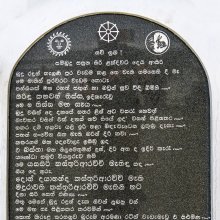Kot: 2 definitions
Introduction:
Kot means something in Hindi, biology. If you want to know the exact meaning, history, etymology or English translation of this term then check out the descriptions on this page. Add your comment or reference to a book if you want to contribute to this summary article.
Ambiguity: Although Kot has separate glossary definitions below, it also represents an alternative spelling of the word Kota.
Images (photo gallery)
Biology (plants and animals)
Source: Google Books: CRC World Dictionary (Regional names)Kot in India is the name of a plant defined with Saussurea costus in various botanical sources. This page contains potential references in Ayurveda, modern medicine, and other folk traditions or local practices It has the synonym Aucklandia lappa Decne. (among others).
Example references for further research on medicinal uses or toxicity (see latin names for full list):
· Transactions of the Linnean Society of (1845)
· Annals and Magazine of Natural History (1841)
· Botanicheskii Zhurnal (1964)
· Archives de Botanique (1833)
· CIS Chromosome Inform. Serv. (1993)
· Compositae Indicae (1876)
If you are looking for specific details regarding Kot, for example chemical composition, diet and recipes, health benefits, pregnancy safety, extract dosage, side effects, have a look at these references.

This sections includes definitions from the five kingdoms of living things: Animals, Plants, Fungi, Protists and Monera. It will include both the official binomial nomenclature (scientific names usually in Latin) as well as regional spellings and variants.
Languages of India and abroad
Hindi dictionary
Source: DDSA: A practical Hindi-English dictionaryKot in Hindi refers in English to:—(nm) a coat; citadel, castle; ~[pala] the governor of a citadel..—kot (कोट) is alternatively transliterated as Koṭa.
...
See also (Relevant definitions)
Starts with (+1158): Kot chulaalamphuaua, Kot kak kra, Kot-pulinayanar, Kota, Kota-adhikaranika, Kota-dimbula, Kota-khar, Kotaashori, Kotaba, Kotacakra, Kotacalakkulikai, Kotacari, Kotacika, Kotacori, Kotaculi, Kotacuri, Kotadi, Kotadi chettu, Kotadiabli, Kotado.
Ends with (+4): Angkot, Ankot, Chakot, Chalta korkot, Chotokot, Dokot-dokot, Halikot, Handalokot, Jongkot, Kakkakkot, Korkot, Krokot, Mangalkot, Mkot, Neen kotkot, Nkwa ikot, Petikot, Pisirokot, Punkot, Rakot.
Full-text: Kot chulaalamphuaua, Kot kak kra, Nagarakoti, Kota, Kutuhala, Devikota, Devakota, Piprawa, Ahicchatra, Kotivarsha, Kapilavastu.
Relevant text
Search found 6 books and stories containing Kot; (plurals include: Kots). You can also click to the full overview containing English textual excerpts. Below are direct links for the most relevant articles:
Settlement in Early Historic Ganga Plain (by Chirantani Das)
Part 3 - Important trade routes of Vārāṇasī < [Conclusion]
The Religion and Philosophy of Tevaram (Thevaram) (by M. A. Dorai Rangaswamy)
Chapter 55 - Thiruvennainallur and Thirunavalur (Hymn 17) < [Volume 3.5 - Pilgrim’s progress: to the North]
Chapter 2 - The cult of Atiyars (Adiyars) < [Volume 4.1.2 - The conception of Paramanaiye Paduvar]
Chapter 3.4 - Gajaha-murti (the story of killing Gajasura) < [Volume 2 - Nampi Arurar and Mythology]
Mahavamsa (by Wilhelm Geiger)
Vastu-shastra (5): Temple Architecture (by D. N. Shukla)
Temple architecture in Kashmir < [Chapter 12 - History of Hindu Temples (Prāsādas and Vimānas)]
Folk Tales of Gujarat (and Jhaverchand Meghani) (by Vandana P. Soni)
Chapter 6 - Natho Modhvadio (Around 1830) < [Part 2 - Sorathi Baharvatiya]
The Great Buddhist Emperors of Asia (by Shibani Dutta)
